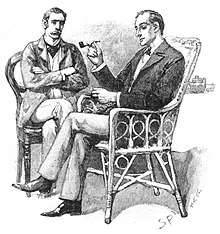Baritsu
Baritsu is the name given to a form of martial art described by Sir Arthur Conan Doyle in the 1903 Sherlock Holmes story "The Adventure of the Empty House", the first of The Return of Sherlock Holmes. Baritsu was used to explain how Holmes had managed to avoid falling into the Reichenbach Falls with Professor Moriarty as described in the 1893 story "The Final Problem". "The Adventure of the Empty House" was first published in Collier's on 26 September 1903.[1][2]
It is almost certainly a misspelling of the real martial art of Bartitsu, which existed in Britain around the time Doyle's novels were written.[3]
History
By the 1890s, Conan Doyle had become weary of chronicling the adventures of Sherlock Holmes. He had ostensibly killed Holmes off in his 1893 story, "The Final Problem", in which Holmes apparently plunged to his death over a waterfall during a struggle with his arch-enemy, Professor Moriarty.
However, such was the public clamour for the fictional detective’s return that Doyle capitulated and revived Holmes for another story, "The Adventure of the Empty House", in 1903. As Holmes himself explained his apparently miraculous survival:
When I reached the end I stood at bay. He drew no weapon, but he rushed at me and threw his long arms around me. He knew that his own game was up, and was only anxious to revenge himself upon me. We tottered together upon the brink of the fall. I have some knowledge, however, of baritsu, or the Japanese system of wrestling, which has more than once been very useful to me. I slipped through his grip, and he with a horrible scream kicked madly for a few seconds and clawed the air with both his hands. But for all his efforts he could not get his balance, and over he went. With my face over the brink I saw him fall for a long way. Then he struck a rock, bounced off, and splashed into the water.
The term baritsu developed a life of its own during the later 20th century, and it was duly recorded that fictional heroes including Doc Savage and the Shadow had been initiated into its mysteries; those last two were established as knowing baritsu in a DC-published crossover that spilled over into The Shadow Strikes.
In the Soviet series The Adventures of Sherlock Holmes and Dr. Watson, both Holmes and Moriarty are masters of baritsu. A dramatic battle between the two is shown.[4]
Bartitsu
In 1982 Fromm and Soames, followed by others including Y. Hirayama, J. Hall, Richard Bowen, and James Webb, suggested that Doyle had meant to refer to Bartitsu, an eclectic martial art that had been founded by Londoner E. W. Barton-Wright in 1899: several years after Holmes had supposedly used it, but two years before publication of the story.[5]
It is uncertain why Holmes referred to "baritsu", rather than "Bartitsu". It is possible that Doyle, who, like Barton-Wright, was writing for Pearson’s Magazine during the late 1890s, was vaguely aware of Bartitsu and simply misremembered or misheard the term, perhaps in part due to Japanese phonology's prohibition on consecutive non-nasal consonants; it may even have been a typographical error, a concern about copyright, or a deliberate alteration to match the aforementioned Japanese phonological pattern. A newspaper report on a Bartitsu demonstration in London, published in 1900, had likewise misspelled the name as "baritsu".[6]
Japan Sherlock Holmes Club
This club, formed in 1977,[7] evolved from the "Baritsu Chapter" founded 1948.[8] The club currently (2009) has around 1000 members.[7]
The Japanese club erected the first plaque to Holmes in London, in 1953.[9] In 2011 they erected a plaque to Dr Joseph Bell, the inspiration behind Holmes' character.[10]
References
- Doyle, A. Conan (October 1903). "The Return of Sherlock Holmes: The Adventure of the Empty House". The Strand Magazine. XXVI (154). Retrieved 7 June 2016.
- Miller, Russell (2008). The Adventures of Arthur Conan Doyle: A Biography. Thomas Dunne Books. p. 246. ISBN 0312378971.
empty house doyle baritsu.
- Tracy, Jack (1977). The Ultimate Sherlock Holmes Encyclopedia. Gramercy Books. p. 25. ISBN 0-517-65444-X.
- LFV (27 May 2011). "The Adventures of Sherlock Holmes and Dr. Watson (Part 2)". YouTube. Retrieved 22 February 2018.
- Fromm, Alan; Soames, Nicolas (1982). Judo: The Gentle Way. London: Routledge & Kegan Paul. ISBN 978-0-71009-025-6.
- Godfrey, Emelyne (5 May 2009). "Sherlock Holmes and the Mystery of Baritsu". History Today. 59 (5): 4–5. Retrieved 22 February 2018.
- Redmond, Christopher (2009). Sherlock Holmes Handbook: Second Edition. Dundurn Press. pp. 283–284. ISBN 9781459718982.
- Hirayama, Yuichi (2013). East Wind Coming: A Sherlockian Study Book. MX Publishing. ISBN 978-1780923802.
- Webb, Keith E. (1998). Sherlock Holmes in Japan. Nextchurch. p. 24. ISBN 978-0966565812.
- Shimizu, Takeshi. "Sherlock Holmes inspiration honoured in Scotland". Embassy of Japan in UK. Retrieved 11 December 2019.
Bibliography
- Alan Fromm, Nicolas Soames, Judo: The gentle way, Routledge, 1982, ISBN 0-7100-9025-0, pp. 7–8
- Hirayama, Yuichi and John Hall. Some Knowledge of Baritsu: An Investigation of the Japanese system of wrestling used by Sherlock Holmes. Huddersfield (Northern Musgraves Sherlock Holmes Society, 1996. Musgrave Monograph Number Seven)
- Mamatas, Nick, "Bartitsu: The Martial Art for the Steampunk Set", Clarkesworld 39, December 2009
- Noble, Graham. "An Introduction to E. W. Barton-Wright (1860–1951) and the Eclectic Art of Bartitsu". Journal of Asian Martial Arts, 1999, v. 8:2, pp 50–61
- Webb, James. Obvervations on Bartitsu: Monograph, 2002
- Wolf, Tony (Ed.) The Bartitsu Compendium, (Lulu Publications, 2005)
